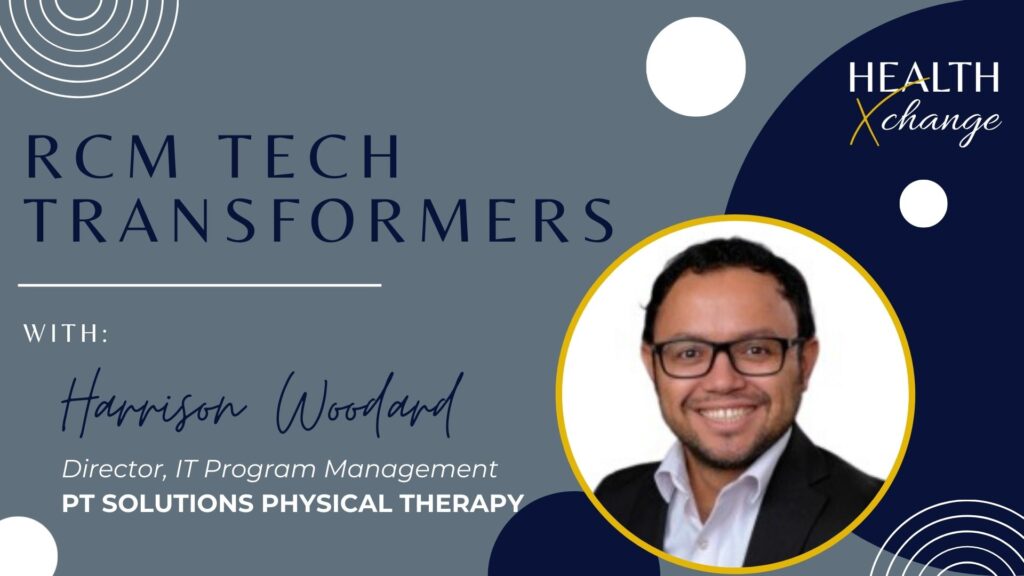Ahead of the Revenue Cycle AI, Automation, and Analytics meeting on Tuesday, May 21st, we had the opportunity to meet with panelists to learn more about their professional journeys, current priorities, and areas they are looking forward to benchmarking and discussing with peers at the forthcoming event. In this interview with Director of IT Program Management Harrison Woodard, we learn more about his route into the healthcare industry, areas of interest including the application of Web3 technologies into the revenue cycle, and how he and his team are developing comprehensive scorecards to evaluate potential vendor partners.
Can you provide an overview of your professional journey thus far, including the roles and responsibilities you are undertaking in your current position?
My professional journey has been diverse and rewarding. I began as a Production Supervisor at a logistics company before becoming a PMO Analyst at a healthcare consulting firm. I then advanced to roles such as Business Analyst and IT Project Manager for the Americas Region at a Swiss logistics and supply chain company, and later IT Project Manager for a prominent hospital system in middle Tennessee.
My career progressed to IT Portfolio Manager for the Americas Region at a French logistics and supply chain company, followed by Director of Program Management, Business Transformation, and Software Engineering at a healthcare company. Afterward, I served as Senior Manager of Digital Transformation at a major US healthcare company.
Currently, I am the Director of IT Program Management at PT Solutions, where I’m responsible for overseeing IT initiatives, managing a portfolio of projects, and driving strategic technology programs that align with organizational goals. My role includes coordinating cross-functional teams to deliver impactful results and ensuring smooth execution across various initiatives.
What emerging technology trends do you anticipate either enhancing workflows, or disrupting the revenue cycle entirely?
Web3 technologies have the potential to revolutionize revenue cycle management (RCM) by enhancing efficiency, transparency, and security. Decentralized data management through blockchain ensures patient data is stored across a distributed network, minimizing breach risks while securing transactions.
Blockchain’s shared data also improves claims processing by reducing discrepancies, as authorized stakeholders can access consistent information. Smart contracts automate tasks like eligibility verification, reducing errors and speeding up revenue collection, while encoded billing terms improve transparency and minimize disputes. Immutable blockchain records help detect and prevent fraudulent billing, while peer-to-peer transactions eliminate intermediaries, lowering costs and speeding up payments.
Web3 could also enhance patient engagement through tokenization, rewarding healthy behaviors that directly support RCM processes. Blockchain’s secure data tracking simplifies compliance with regulations like HIPAA.
However, Web3 technologies are still evolving and may not yet meet large-scale healthcare needs.
Uncertain regulations, especially around data privacy, and the challenge of integrating Web3 with existing IT systems present significant hurdles. Overall, Web3 offers tremendous potential to transform RCM, but technological and regulatory barriers must be overcome for successful adoption.
When it comes to developing vendor scorecards or selection criteria, what would your advice be to fellow peers and colleagues in the industry?
When developing vendor scorecards or selection criteria, it’s important to follow a structured approach. Here’s my advice:
Understand Your Objectives: Start by identifying your organization’s specific goals and needs. The scorecard should reflect the priorities that are most crucial for your business, whether it’s cost-efficiency, innovation, scalability, or customer support.
Define Key Metrics: Determine which metrics are essential for evaluating vendors. Consider criteria like product functionality, integration capabilities, technical support, compliance, cost, and vendor reputation. Make these metrics measurable to ensure objective assessments.
Involve Key Stakeholders: Include input from all relevant departments that will be affected by the vendor’s performance. This ensures the scorecard covers a comprehensive range of concerns and aligns with organizational goals.
Weight the Criteria: Not all criteria are equally important, so assign different weights to each based on their priority to your organization. This will help balance the evaluation.
Gather Data Consistently: Ensure consistency in how data is collected and scored. Utilize a standardized approach to rate vendors based on how well they meet each criterion.
Benchmark Against Competitors: Compare potential vendors against industry benchmarks and their competitors to see how they measure up, and to set realistic expectations.
Consider Long-term Partnerships: Evaluate the vendor’s financial stability, future product roadmap, and willingness to adapt to your evolving needs. Look for partners with a shared vision.
Review Regularly: Revisit the scorecard periodically to refine the criteria and metrics based on changing business needs or market conditions. This ensures that your selection process remains relevant and effective.
Thank you so much, Harrison, for these thoughtful responses and for sharing the criteria being used to evaluate potential technology partners. We look forward to Harrison’s participation in the upcoming panel, and to hearing from all of the panelists on May 21st.

